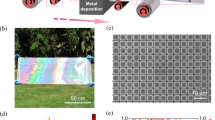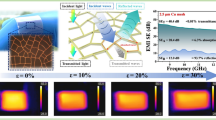Abstract
This study focuses on the fabrication and characterization of a transparent conductive window with high transmission properties. The window is created by depositing optimized antireflection layers on quartz glass to emphasize the spectral range of 450–800 nm at an incidence angle of 35°. The deposition process involves an antireflection layer to minimize reflection and achieve a transmission level above 91% within the specified spectral range. The thin film demonstrates the excellent optical properties of the fabricated transparent conductive window, making it suitable for a wide range of applications requiring high transmission and resistance to laser-induced damage. This research provides insights into the fabrication and performance of transparent conductive windows, laying the groundwork for potential applications in optics and industrial settings.















Similar content being viewed by others
References
E. Acosta, Thin Films/Properties and Applications (London: Intech Open, 2021), pp.1–19.
F. Catania, H. de Souza Oliveira, P. Lugoda, G. Cantarella, and N. Münzenrieder, Thin-film electronics on active substrates: review of materials, technologies and applications. J. Phys. D Appl. Phys. 55, 323002 (2022).
R. Shwetharani, H.R. Chandan, M. Sakar, G.R. Balakrishna, K.R. Reddy, and A.V. Raghu, Photocatalytic semiconductor thin films for hydrogen production and environmental applications. Int. J. Hydrog. Energy 45(36), 18289 (2020).
H. Kim, J.S. Horwitz, G. Kushto, A. Piqué, Z.H. Kafafi, C.M. Gilmore, and D.B. Chrisey, Effect of film thickness on the properties of indium tin oxide thin films. J. Appl. Phys. 88, 6021 (2000).
W.S. Leung, Y.C. Chan, and S.M. Lui, A study of degradation of indium tin oxide thin films on glass for display applications. Microelectron. Eng. 101, 1 (2013).
S.M. Shang and W. Zeng, Conductive nanofibres and nanocoatings for smart textiles, Multidisciplinary Know-How for Smart-Textiles Developers. ed. T. Kirstein (Amsterdam: Elsevier, 2013), pp. 92–128.
J.T. Gudmundsson, A. Anders, and A.V. Keudell, Foundations of physical vapor deposition with plasma assistance. Plasma Sources Sci. Technol. 31, 083001 (2022).
P. Lippens and U. Muehlfeld, Indium tin oxide (ITO): sputter deposition processes, Handbook of Visual Display Technology. ed. J. Chen, W. Cranton, and M. Fihn (Berlin, Heidelberg: Springer, 2012), pp. 779–794.
N. Nedelcu, V. Chiroiu, L. Munteanu, I. Girip, C. Rugina, A. Lőrinczi, E. Matei, and A. Sobetkii, Design of highly transparent conductive optical coatings optimized for oblique angle light incidence. Appl. Phys. A 127, 575 (2021).
N. Nedelcu, Thin Films: Processes and Characterization Techniques (New York: Springer, 2023).
A.M.B. van Mol, Y. Chae, A.H. McDaniel, and M.D. Allendorf, Chemical vapor deposition of tin oxide: fundamentals and applications. Thin Solid Films 502(1–2), 72 (2006).
M.A. Butt, Thin-film coating methods: a successful marriage of high-quality and cost-effectiveness—a brief exploration. Coatings 12(8), 1115 (2022).
Z. Liu, Y. Xie, J. Zhao, S. Wu, Z. Zhou, M. Wen, Y.B. Cheng, and J. Zhong, Rapid preparation of conductive transparent films via solution printing of graphene precursor. Thin Solid Films 657, 24 (2018).
D. Li, W.Y. Lai, Y.Z. Zhang, and W. Huang, Printable transparent conductive films for flexible electronics. Adv. Mater. 30(10), 1704738 (2018).
D.W. Kim, S.W. Kim, G. Lee, J. Yoon, S. Kim, J.H. Hong, S.C. Jo, and U. Jeong, Fabrication of practical deformable displays: advances and challenges. Light Sci. Appl. 12, 61 (2023).
C. Ouyang, D. Liu, K. He, and J. Kang, Recent advances in touch sensors for flexible displays. IEEE Open J. Nanotechnol. 4, 36 (2022).
Y. Sung, R.E. Malay, X. Wen, C.N. Bezama, V.V. Soman, M.H. Huang, S.M. Garner, D.M. Poliks, and D. Klotzkin, Anti-reflective coating with a conductive indium tin oxide layer on flexible glass substrates. Appl. Opt. 57(9), 2202 (2018).
M.F. Al-Kuhaili, Transparent-conductive and infrared-shielding WO3/Ag/WO3 multilayer heterostructures. Sol. Energy 250(2023), 209 (2023).
D. Zhang, I.A. Digdaya, R. Santbergen, R.A.C.M.M. van Swaaij, P. Bronsveld, M. Zeman, J.A.M. van Roosmalen, and A.W. Weeber, Design and fabrication of a SiOx/ITO double-layer anti-reflective coating for heterojunction silicon solar cells. Solar Energy Mater. Solar Cells 117, 132 (2013).
Y. Zhong, Y.C. Shin, C.M. Kim, B.G. Lee, E.H. Kim, Y.J. Park, K.M.A. Sobahan, C.K. Hwangbo, Y.P. Lee, and T.G. Kim, Optical and electrical properties of indium tin oxide thin films with tilted and spiral microstructures prepared by oblique angle deposition. J. Mater. Res. 23, 2500 (2008).
M.K. Basher, S.M. Shah Riyadh, M.K. Hossain, H. Mahmudul, Md.A.R. Akand, S.M. Amir-Al Zumahi, MdAb. Matin, N. Das, and M. Nur-E-Alam, Development of zinc-oxide nanorods on chemically etched zinc plates suitable for high-efficiency photovoltaics solar cells. Opt. Quant. Electron. 55, 322 (2023).
J. Liu, C. Wang, Z. Dang, Y. Chu, and Z. Zhang, Thermally, resettable laser transmission induced transparency in polymer waveguides at 635 nm. Opt. Express 30(10), 17529 (2022).
Y. Ren, P. Liu, R. Liu, Y. Wang, Y. Wei, L. Jind, and G. Zhao, The key of ITO films with high transparency and conductivity: grain size and surface chemical composition. J. Alloy. Compd. 893, 162304 (2022).
J. Zou, C. Dong, H. Wang, T. Du, and Z. Luo, Towards visible-wavelength passively mode-locked lasers in all-fibre format. Light Sci. Appl. 9, 61 (2020).
J. Krüger and W. Kautek, Femtosecond pulse visible laser processing of fibre composite materials. Appl. Surf. Sci. 106, 383 (1996).
E.W. Van Stryland, M.J. Soileau, A.L. Smirl, and W.E. Williams, Pulse-width and focal-volume dependence of laser-induced breakdown. Phys. Rev. B 23, 2144 (1981).
International Standard ISO 11254-1 First edition 2000-06-01 (2003).
R.J. Swanepoel, Determination of the thickness and optical constants of amorphous silicon. J. Phys. E Sci. Instrum. 16, 1214–1222 (1980).
J.C. Manifacier, J. Gasiot, and J.P. Fillard, A simple method for the determination of the optical constants n, k and the thickness of a weakly absorbing thin film. J. Phys. E 9, 1002–1004 (1976).
J. Tauc, Amorphous and Liquid Semiconductors (London: Plenum Press, 1974).
S.H. Wemple and M. DiDomenico, Behavior of the electronic dielectric constant in covalent and ionic materials. Phys. Rev. B 3, 1338 (1971).
S.H. Wemple, Refractive-index behavior of amorphous semiconductors and glasses. Phys. Rev. B 7, 3767 (1973).
N. Nedelcu, V. Chiroiu, L. Munteanu, and I. Girip, Characterization of GeSbSe thin films synthesized by the conventional melt-quenching method. IR Spectrosc. Today’s Spectrosc. 35(S3), 22 (2020).
K. Tanaka, Structural phase transitions in chalcogenide glasses. Phys. Rev. B 39(2), 1270 (1989).
N. Stan, N. Nedelcu, V. Chiroiu, L. Munteanu, and M. Ionescu, Optical and Morphological investigation of chalcogenide Ge-Sb-Te thin films. Proc. Roman. Acad. A 23, 245 (2022).
N.F. Mott and E.A. Davis, Electronic processes in non-crystalline materials. Phys. Today 25(12), 55 (1972).
Author information
Authors and Affiliations
Corresponding author
Ethics declarations
Conflict of interest
The authors declare that they have no known competing financial interests or personal relationships that could have appeared to influence the work reported in this paper. The authors declare that they have no conflicts of interest.
Additional information
Publisher's Note
Springer Nature remains neutral with regard to jurisdictional claims in published maps and institutional affiliations.
Rights and permissions
Springer Nature or its licensor (e.g. a society or other partner) holds exclusive rights to this article under a publishing agreement with the author(s) or other rightsholder(s); author self-archiving of the accepted manuscript version of this article is solely governed by the terms of such publishing agreement and applicable law.
About this article
Cite this article
Nedelcu, N., Webb, D., Ackroyd, N. et al. Optimizing High-Transmission Conductive Windows with Antireflection Coating for Oblique Angle Light Incidence. J. Electron. Mater. (2024). https://doi.org/10.1007/s11664-024-11133-6
Received:
Accepted:
Published:
DOI: https://doi.org/10.1007/s11664-024-11133-6




